This guide is about Gateway recovery disks for the following versions of Windows: Windows XP, Windows Vista, Windows 7 and Windows 8.

A recovery disk is also known as a restore disc, repair disc, boot disc or rescue disk.
Gateway Computers acquired eMachines Computers in 2004 and, in 2007, Gateway Computers was acquired by Acer.
- If you have a computer from Acer, follow the Acer Recovery Disk guide instead.
- If you have a computer from eMachines, follow the eMachines Recovery Disk guide instead.
Looking for a recovery disk for Gateway? Download Easy Recovery Essentials, our recovery and repair disk for Gateway computers.
Contents
Download alternative recovery disk for Gateway
If the recovery partition of your computer is corrupt or damaged, consider downloading Easy Recovery Essentials, that it’s compatible with Gateway computers running Windows XP, Vista, 7 and 8.
Easy Recovery Essentials works for any Gateway model and it’s compatible with the following Windows versions:
- Microsoft Windows 8 (read more on our Windows 8 Recovery Disk and Repair Disc Download article)
- Microsoft Windows 7 (read more on our Windows 7 Recovery Disk and Repair Disc Download article)
- Microsoft Windows Vista (read more on our Windows Vista Recovery Disk and Repair Disc Download article)
- Microsoft Windows XP (read more on our Windows XP Recovery and Repair Disk article)
- Microsoft Windows Server 2003, 2008 and 2012 (read more on our Windows Server 2008 and 2012 Recovery Discs Download article)
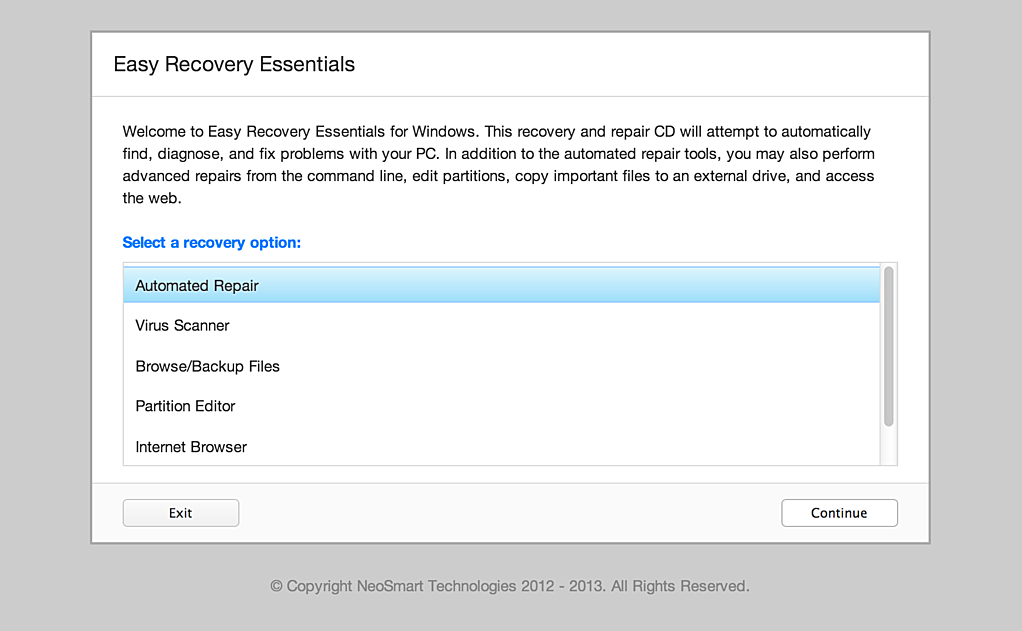
Screenshot of Easy Recovery Essentials
You can burn Easy Recovery Essentials directly to a CD, DVD or a USB flash drive and use its Automated Repair function to automatically find and fix boot errors.
Download Easy Recovery Essentials for Gateway
Note: Easy Recovery Essentials can not be used to install or reinstall Windows.
Create recovery disks for Gateway with Gateway Recovery Center
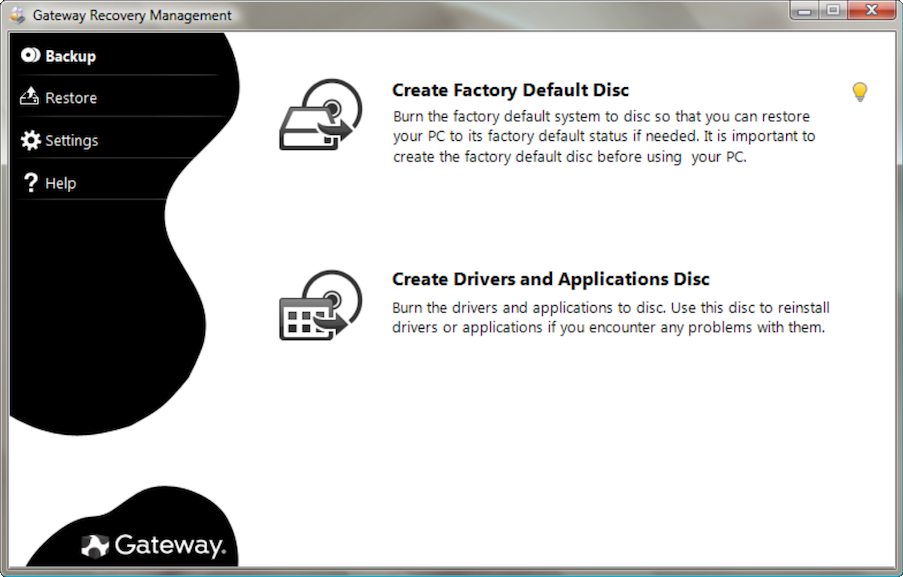
The Gateway Recovery Management software
Your computer runs the Acer software if it looks like this:
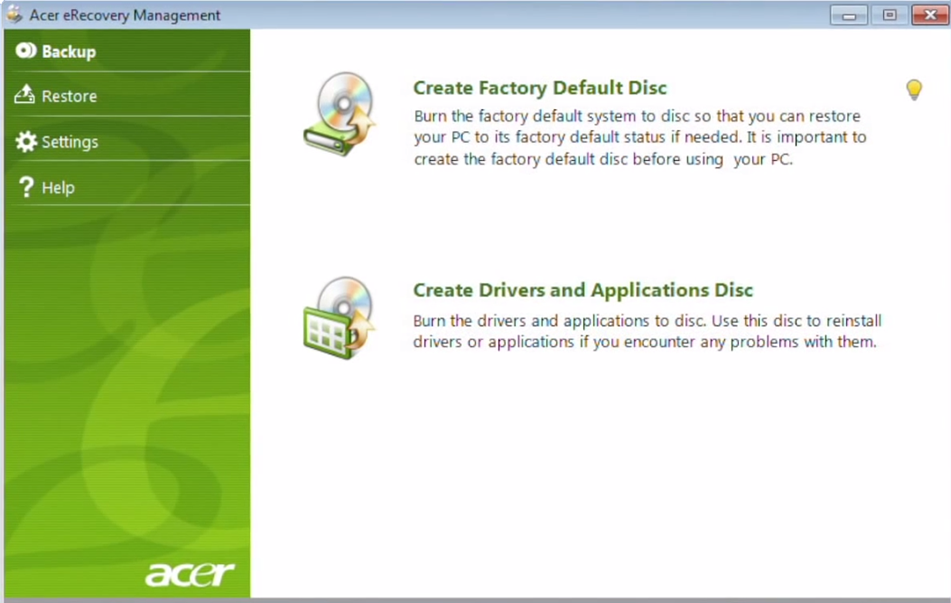
The Acer eRecovery Management software
Gateway computers shipped after November, 2004 have a backup solution called Gateway System Recovery.
This solution is a recovery partition stored on your computer’s hard drive that can be used to restore Windows. Using this partition, you can also create a set of recovery disks in case the partition becomes damaged or corrupt.
Your computer may still have a recovery partition intact (undamaged or uncorrupted) that can be used to restore your computer to its factory conditions. You can check if the partition is still intact by:
- Restarting your computer
- When the Gateway logo appears, press the Alt (the left key) and F10 keys during the boot process
Create the recovery disk in Windows XP
Windows XP users can create the recovery disks for Gateway computers by following these steps.
Make sure your CDs are “CD-R” and not “CD-RW”. If you plan to use DVDs, they must be “DVD-R” and not “DVD-RW” or “DVD+RW”.
- Power on the computer
- Go to Start > All Programs
- Find the System Recovery folder
- Click on Create My Drivers-Applications CD(s)
- Click Burn ISO when the “Do you want to burn the created ISO images or just having them placed in a folder of your choice” message appears
- At the Recovery CD/DVD Creator screen, click Start Creation
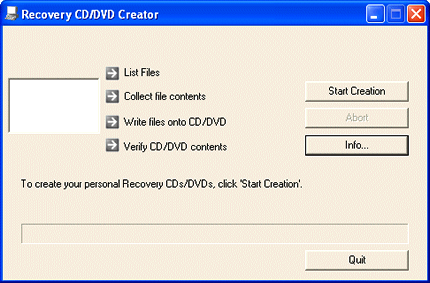
Gateway Recovery CD/DVD software
- The software will let you know how many CDs or DVDs you need to complete the process
- Choose what type of media you plan to use – CD or DVD – by selecting the respective option.
Example: Select “Number of DVDs required: 1” if you plan to use DVD as a recovery media.
- Insert your first blank media in the optical drive
- Click OK
- Wait for the process to finish

Writing to CD or DVD
- When the software program prompts you to insert the next blank disk, do so
- When the “The Recovery ISO Image has been created successfully” message appears, remove the last disk from the optical drive
- Click OK
- Label the recovery disks and keep them safe!
Create the recovery disk in Windows Vista
Windows Vista users can create a recovery disk using the Gateway Recovery Centre software program by following these steps.
Your Windows Vista may run the Gateway Recovery Management software and not the Gateway Recovery Centre software version. If so, follow the instructions from Windows 7.
These steps will create a backup copy of your system’s drivers and application and will not include a copy of your Windows Vista. You can reinstall Windows Vista using the backup media (the original Windows Vista media).
- Turn on your computer
- Go to Start and then to All Programs
- Find a Gateway Recovery Center folder and click on the Gateway Recovery Center item
- If Windows Vista’ User Account Control (UAC) dialog appears, click Continue or Yes
- When the Welcome to Gateway Recovery Center appears, click on Applications and Drivers external media
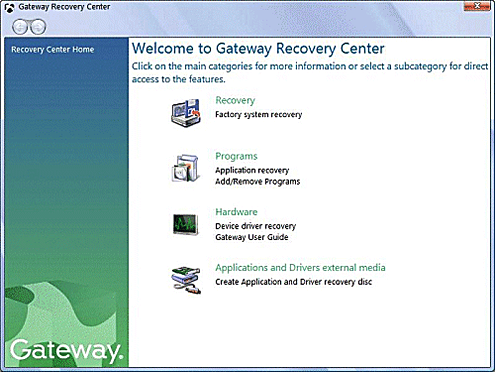
Gateway Recovery Centre in Windows Vista
- Click Next
- Make sure the Create system recovery discs option is selected and then click Next
- Insert a blank CD or DVD in the optical drive. The software will notify you how many CDs or DVDs you will need to complete the processing, depending if you are using a CD or a DVD.
- Select I have enough discs, continue with this type of media and click Next
- Wait for the process to finish
- When the Congratulations screen appears, click Next
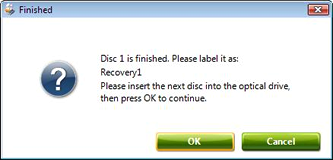
Disk created! Process complete!
Create the recovery disk in Windows 7
Windows 7 users can create the set of recovery disks using the Gateway Recovery Management software. Follow these instructions.
- Turn on your computer
- Go to Start and then to All Programs
- Find a Gateway folder
- Click on Gateway Recovery Management
- Select Create factory default disc
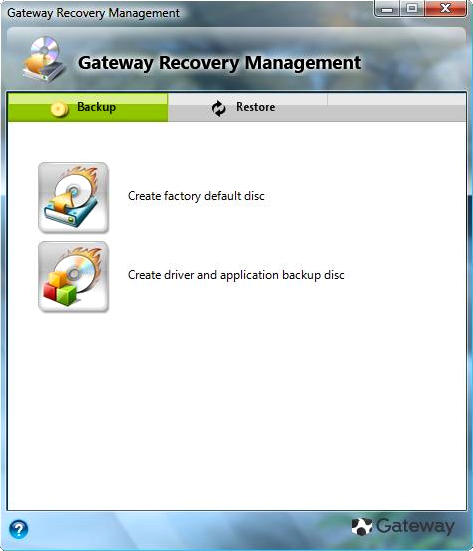
Gateway Recovery Management in Windows 7
- At the Create Backup Disc screen, insert your first blank CD or DVD and make sure the optical drive is selected at the “Burn to” item. The software will let you know how many CDs and DVDs you need, if you plan to use either a CD or a DVD
- Click Start
- The software will prompt you to insert the next blank CD or DVD to continue the process
- Insert a new blank media and click OK

Disk created. Continue with the next blank disk.
- When the process is complete, click OK to exit the software program
Create the recovery disk in Windows 8
Windows 8 users can use a USB flash drive to create a recovery disk for Gateway computers using the Gateway Recovery Management software program. The instructions are below.
This action will remove all personal files from your USB flash drive.
- Press the
key and Q
- Type “recovery” when the search field appears
- When the first search results appears, click on Gateway Recovery Management
- Select Create Factory Default Disc

Click on Create Factory Default Disc
- Select Copy content from the recovery partition to the recovery drive
- Click Next
- Select the USB flash drive to use as a recovery media from the list. You can also use DVDs as a recovery media
- Click Next
- Click Create
- If you are being asked to delete the recovery partition from your computer, click No
Restoring a Gateway computer
Users of Gateway computers can restore the system either by booting into Windows and use the installed recovery software, use the recovery partition from Gateway or use the recovery disks created with the software program.
Restore Windows XP
Windows XP can be restored using the recovery disks created for your Gateway computer by following these instructions.
All personal files will be deleted during the restore process. Backup your files before you continue!
- Remove any USBs, printers, cameras etc. connected to your computer
- Insert the first recovery disk in the optical drive
- Boot your computer
- When the following message appears, hit R:
Gateway System Recovery Press 'R' to display Gateway System Recovery options.
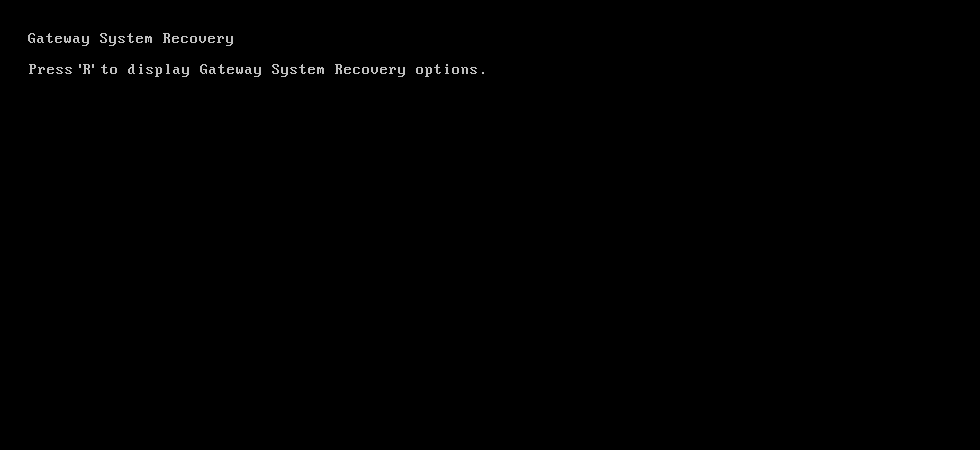
Gateway Windows XP Recovery: Press R
- Hit R again when the following message appears to boot into Gateway System Recovery: (Note: Some recovery disks may not have a F option)
Press 'R' for standard Gateway System Recovery options. You will boot into the recovery partition or on CD if no recovery partition is found. Press 'F' to format drive and perform a full system recovery. All data will be lost! Note: This option will install a recovery partition first, then restore the user partition. Press 'Q' to quit and boot the OS on hard disk.
- When the System Restore Options screen appears, choose Full System Restore (Destructive)
- Click Next
- Click Yes when the Format and Recover dialog appears with the following message:
All files, including data files, on the user partition will be lost and the original factory-shipped files will be recovered to the user partition. Do you want to continue?
- When the software prompts you to insert the next recovery CD, do so. The prompt message is usually “Please insert System Restore CD #2 now” and so on for each recovery CD created.
- When the restore process is done, click Restart
The confirmation message is: “System Restore finished. Restart the PC and remove the CD when the PC boots up“.
- After your computer boots, remove the CD from your optical drive
- Windows XP should now boot with the Installing Devices screen first
Restore Windows Vista
Windows Vista users can restore their Gateway computer by following these instructions.
If you are able to boot into Windows Vista
If you are able to boot into Windows Vista and have the Gateway Recovery Center software program, follow these instructions:
- Power on your computer
- Click on Start > All Programs
- Find the Gateway Recovery Center folder
- Click on Gateway Recovery Center
- If the User Account Control dialog appears, click Continue or Yes to allow the software program to make the necessary changes
- At the Welcome to Gateway Recovery Center screen, choose Recovery

Select Recovery from this list
- Make sure Yes, restart my computer now is selected
- Click Next
- Your computer will now reboot into Windows Recovery Environment (WinRE) from which you can choose multiple utilities: Startup Repair, System Restore etc.
If your recovery partition is intact, the last item in the System Recovery Options window should be “Recovery Manager” which you can use for your Gateway computer.
- Click on Recovery Manager item from the screen, if this item is available, and follow any wizard instructions to restore Windows Vista
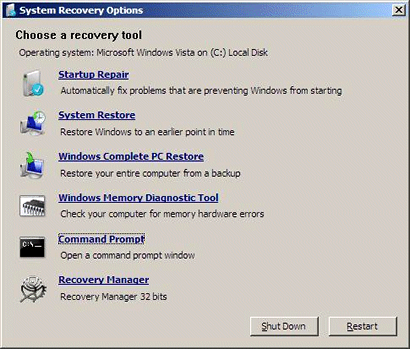
The Gateway Recovery Manager item at System Recovery Options
- The following steps apply if Recovery Manager is available
- When Gateway Recovery Center opens, click Next
- Select Full factory recovery and then click Next
- At the “Are you sure you want to continue” screen, select Yes and click Next
This action erases all your personal data. Backup your files!
- Wait for the process to finish. When the Recovery is complete screen appears, click Finish
- If the System Recovery Options screen appears again, click Restart to restart the computer
- Follow any installation wizard instructions to setup Windows Vista again
If you can’t boot into Windows Vista
If your recovery partition from Gateway is undamaged and you can’t boot into Windows Vista, you can follow these steps:
- Remove any external devices from your computer, except your mouse and your keyboard
- Remove any CDs, DVDs or USBs from your computer
- Turn on your computer
- When the Gateway logo appears, hit F8 multiple times
- The Advanced Boot Options screen should appear:

Advanced Boot Options in Windows Vista on a Gateway
- Use your up and down arrow to highlight (select) the Repair Your Computer option
- Once selected, hit Enter
- Select your keyboard layout
- Click Next
- Login as Administrator and then click OK. If you don’t have an “Administrator” account, use any account that has administrative rights to the system.
- At the System Recovery Options window, select Recovery Manager:

The Gateway Recovery Manager item at System Recovery Options
- When Gateway Recovery Center opens, click Next
- Select Full factory recovery
- Click Next
- At the “Are you sure you want to continue” screen, select Yes and click Next
This action erases all your personal data permanently. Backup your files!
- Wait for the process to finish
- When the Recovery is complete screen appears, click Finish
- The System Recovery Options screen may appear again. If so, click Restart.
- Your computer will restart and your Windows Vista begins the reinstallation process
- Follow any installation wizard instructions to setup Windows again
If you have a Gateway recovery disk
If you have a recovery disk for Windows Vista already created, follow the wizard instructions after doing these steps:
- Turn on your computer
- Insert the first recovery disk in the optical drive
- Restart your computer
- Hit F12 to open the boot menu
- Use your up and down arrow keys to select the CD-ROM/DVD item. This would boot from the recovery disk you inserted in the optical drive.
- Hit Enter
- Follow the wizard instructions to restore the system
The above steps should boot your computer into the recovery software program made by Gateway for Windows Vista users. Follow any instructions given by the wizard to restore your computer to factory conditions.
Restore Windows 7
Windows 7 users can restore the system by following these instructions.
If you can boot into Windows 7
If you can still boot into Windows 7, follow these steps:
- Power on your computer
- Go to Start > All Programs
- Select Gateway Recovery Management from the Gateway folder
- When Gateway Recovery Management opens, select the Restore tab:

Select the Restore tab
- Select Restore system to factory default
- Confirm the action by clicking Yes at the Confirm Restoration window
The restore process erases all your personal files. Backup your files!
- Click Start
- Click OK
- When the recovery process has finished, the software prompts you to restart the computer. Click OK to do so.
- Follow the wizard instructions to setup Windows 7 again.
If you can’t boot into Windows 7
If your Gateway recovery partition is still intact and you can’t boot into Windows:
- Power on your computer
- Press the following combination of keys at boot: Alt and F10
- The Gateway Recovery Management software should load
- Select Restore system from factory default
The restore process erases all your personal files. Backup your files!
- Click Next
- Wait for the process to finish
- If a wizard appears: follow the wizard instructions to setup Windows 7 again
If you have the Gateway recovery disk for Windows 7
If you have the Gateway recovery disks created for Windows 7, follow the steps below.
- Turn on your computer
- Insert the first recovery disk in the optical drive
- Restart your computer
- During the startup process, hit F12 to open the boot menu
- Use your up and down arrow keys to select the CD-ROM/DVD item to boot from the recovery disk
- Hit Enter
- Follow the wizard instructions to restore your system
Restore Windows 8
Users of Windows 8 can restore the operating system using the built-in Gateway Recovery Management software.
This action restores the computer to the original factory configuration. This erases all your personal data. Backup your files!
If you can boot into Windows 8
These instructions apply if you are able to boot into Windows 8. If not, follow the next set of instructions.
- Power on your computer
- Press the
key and C to open the Search Charm of Windows 8
- Click on Search and start typing “recovery“
- When the first results appear, click on Gateway Recovery Management
- Click on Restore Factory Settings (at the Restore tab)

Go to the Restore tab
- Click Next
- Select Fully clean the drive option
- Click Reset
- Your computer will now restart and begin the restore process. It may restart again, once the process is done.
If you can’t boot into Windows 8
If you are not able to boot into Windows 8, but have the USB recovery created (using the Gateway Recovery Management software), follow these instructions:
- Power off your computer
- Insert recovery USB flash drive you create with Gateway Recovery Management software
- Power on your computer
- Press F2 to enter BIOS, as soon as your computer boots. If you have a desktop computer, you may need to press Del and not F2.
- Go to the Boot tab from the BIOS screen using the left and right arrow keys
- In the Boot tab screen, you need to find a “USB HDD” item from the list and highlight it by using the up and down arrow keys. USB HDD should be your plugged-in recovery media.
- Once you selected (highlighted) USB HDD, press F6 to move it at the top of the list. You may need to press F6 multiple times to move it at the top of the list.
- When USB HDD is at the top of the list, navigate to the Exit tab using your left and right arrow keys
- Select (or highlight) Exit Saving Changes using your up and down arrow keys
- Hit Enter
- Make sure [Yes] is selected at the dialog screen
- Hit Enter
- Your computer will reboot and boot into Windows 8
- Select a keyboard language
- Click on Troubleshoot
- Click on Reset your PC
- Click Next to confirm the action
This action will erase all your personal files. Backup your files before proceeding!
- Choose Windows 8 from the list
- Select “Yes, repartition the drives” if you no longer have the recovery partition from Gateway to reinstall it. Otherwise, select “No, keep the existing partitions“.
- Select Just remove my files or Fully clean the drive. The last option takes longer, but cleans the entire drive. Fully clean the drive is recommended.
- Click Reset
- The restore process will start
- Once this is complete, at the Choose an option screen, remove the recovery USB.
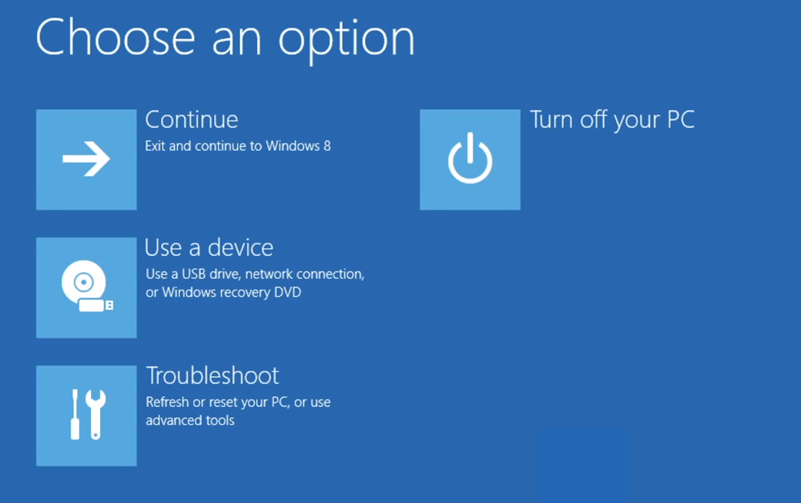
Choose an option at boot
- Click Continue
- Follow any instructions from the wizard screen to setup Windows 8 again
If you don’t have a Gateway recovery USB
If you don’t have the recovery USB created for the Gateway computer, follow these instructions.
These instructions should work if your Gateway recovery partition is intact. If not, consider downloading an alternative recovery disk for Gateway, if your computer is displaying boot errors.
Our recovery and repair disk’s Automated Repair function can automatically find and fix boot errors. Download recovery disk for Gateway from here.
- Restart your computer
- When the PC logo appears, press the Alt (the left key) and F10 keys
- When the Recovery Management software appears, select what kind of restore you want: Restore Operating System to Factory Defaults or Restore Operating System and Retain User Data.
If the Recovery Management software program is branded as “Acer eRecovery Management”, even if your computer is from Gateway: Gateway was acquired by Acer in 2007. Your computer may use the software from Acer. Follow our guide from Acer recovery disks.
- Select Restore Operating System to Factory Defaults and read the Notice screen
- Click Next
- Wait for the restore process to finish. Once it is complete, your Windows should load again by reinstalling the drivers and configuring itself.
More Information
Support Links
- Easy Recovery Essentials for Windows – our repair and recovery disk.
It’s an easy-to-use and automated diagnostics disk. It’s available for Windows 8, Windows 7 and Windows Vista. It’s also available for Windows XP and Windows Server.Read more at Windows Recovery Disks.
- The NeoSmart Support Forums, member-to-member technical support and troubleshooting.
- Get a discounted price on replacement setup and installation discs: Windows XP, Windows Vista, Windows 7, Windows 8.
Applicable Systems
This Windows-related knowledgebase article applies to the following operating systems:
- Windows XP (all editions)
- Windows Vista (all editions)
- Windows 7 (all editions)
- Windows 8 (all editions)
- Windows 8.1 (all editions)
- Windows Server 2003 (all editions)
- Windows Server 2008 (all editions)
- Windows Server 2012 (all editions)
Applicable Models (Gateway)
This Gateway-related knowledge base article applies to the following computer models:
- 400 series: 420
- 500 series: 500, 510, 520, 535, 540, 550, 560
- 600 series: 610, 614, 625, 627, 629
- 700 series: 700, 710, 711, 712, 714
- 800 series: 812GM, 815GM, 816GM, 817GM, 818GM, 819GM, 820GM, 825GM, 827GM, 830, 840GM, 842GM
- 3000 series: 3000, 3500, 3200, 3250, 3310
- 4000 series: 4010, 4020, 4030, 4040, 4520, 4530, 4540
- 5000 series: 5200, 5310
- 6000 series: 6010, 6020, 6510, 6520, 6530, 6830
- 7000 series: 7110, 7210, 7300, 7310, 7320, 7330, 7405, 7410, 7420, 7430, 7500, 7510, 7200, 7310
- 8000 series: 8510, 8550
- 9000 series: 9310
- B series: B-330, B-530, B-730
- C series: C-120, C-140, C-141, C-142, C-143, C-58510
- CX series: CX200, CX210, CX2600, CX2610, CX2620, CX2720, CX2730, CX2750
- DX series: DX100, DX110, DX200, DX210, DX2641, DX2710, DX300, DX310, DX420, DX4200, DX430, DX4300, DX4311, DX4320, DX4350, DX4370, DX4370G, DX4375, DX4375G, DX4380, DX4380G, DX440, DX441, DX442, DX4640, DX4710, DX4720, DX4800, DX4811, DX4820, DX4822, DX4830, DX4831, DX4840, DX4850, DX4860, DX4870, DX4885
- E series: E-1500, E-2100, E-2300, E-2500, E-2600, E-2610, E-4100, E-4300, E-4350, E-4500D, E-4500S, E-4610D, E-4610S, E-4620, E-6100, E-6300, E-6500D, E-6610D, E-6610Q, E-100M, E-155C, E-265M, E-295C, E-475M
- EC series: EC14, EC14D, EC18, EC19C, EC38, EC39C, EC54, EC58
- FX series: FX400, FX4200, FX4710, FX510, FX530, FX540, FX541, FX542, FX6710, FX6800, FX6801, FX6802, FX6803, FX6830, FX6831, FX6840, FX6850, FX6860, FX7020, FX7024, FX7026, FX7028j, FX7029e, FX8000
- GM series: GM3032b, GM4019e, GM4019h, GM5014b, GM5024b, GM5034b, GM5038b, GM5044f, GM5045e, GM5045h, GM5046b, GM5048, GM5048b, GM5052e, GM5066b, GM5066e, GM5067h, GM5072, GM5074b, GM5076e, GM5078b, GM5084, GM5088, GM5089e, GM5091e, GM5091h, GM5094e, GM5258h, GM5259e, GM5259h, GM5260, GM5266e, GM5407e, GM5407h, GM5410e, GM5410h, GM5416e, GM5420, GM5424, GM5442, GM5446e, GM5454e, GM5457e, GM5457h, GM5470e, GM5472, GM5474, GM5478, GM5480e, GM5483e, GM5485e, GM5485h, GM5626, GM5632e, GM5638e, GM5639e, GM5640e, GM5642e, GM5643e, GM5661e, GM5664, GM5684e, GM5688e
- GT series: GT3010m, GT3012m, GT3015m, GT3016b, GT3020b, GT3020m, GT3022b, GT3035m, GT3045m, GT3050m, GT3055m, GT3070m, GT3072m, GT3074m, GT3076m, GT3078m, GT3080m, GT3082m, GT3084m, GT3086m, GT3088m, GT3210m, GT3212m, GT3214m, GT3216m, GT3218m, GT3220m, GT3222m, GT3224m, GT3226m, GT3228m, GT3230m, GT3231m, GT3232m, GT3234m, GT3236m, GT3238m, GT3240m, GT3242m, GT3246m, GT3248m, GT3250m, GT3252m, GT4009, GT4010, GT4012j, GT4014j, GT4015e, GT4015h, GT4016, GT4016j, GT4022, GT4023e, GT4024, GT4026e, GT4220m, GT4222m, GT4224m, GT4226m, GT4228m, GT4230m, GT5010c, GT5012, GT5012b, GT5012c, GT5012h, GT5014, GT5014c, GT5014h, GT5016c, GT5016e, GT5016h, GT5018e, GT5020j, GT5022j, GT5026e, GT5026f, GT5026j, GT5028, GT5028h, GT5030j, GT5032, GT5034, GT5036j, GT5038j, GT5040, GT5040h, GT5042b, GT5042j, GT5044j, GT5048j, GT5052b, GT5054b, GT5056, GT5056b, GT5056h, GT5056j, GT5058, GT5058j, GT5062b, GT5062e, GT5062j, GT5064, GT5064h, GT5068e, GT5072b, GT5078e, GT5082, GT5082b, GT5082h, GT5082j, GT5084j, GT5086b, GT5086j, GT5092b, GT5092j, GT5094j, GT5096j, GT5098e, GT5098j, GT5212j, GT5214j, GT5216j, GT5218j, GT5220, GT5222e, GT5224, GT5224j, GT5226j, GT5228, GT5228j, GT5232e, GT5232h, GT5235e, GT5235h, GT5236j, GT5238e, GT5240j, GT5242e, GT5244e, GT5252, GT5256c, GT5262c, GT5263e, GT5264c, GT5268e, GT5272e, GT5276b, GT5278b, GT5404, GT5405e, GT5405h, GT5408, GT5411e, GT5412, GT5414e, GT5418e, GT5422e, GT5426e, GT5428, GT5429h, GT5430e, GT5432, GT5435e, GT5436e, GT5438, GT5448e, GT5449e, GT5452e, GT5453e, GT5453h, GT5456h, GT5458e, GT5464, GT5465e, GT5468, GT5473e, GT5475e, GT5476e, GT5477e, GT5481e, GT5482e, GT5618e, GT5620, GT5622, GT5624e, GT5625e, GT5628, GT5630e, GT5634h, GT5636e, GT5637e, GT5644e, GT5646e, GT5648e, GT5650j, GT5652j, GT5654, GT5656, GT5657e, GT5658e, GT5660e, GT5662, GT5668e, GT5670, GT5672e, GT5674, GT5676, GT5678, GT5680e, GT5685e, GT5686j, GT5692, GT5694
- GX series: GX7010j, GX7018e, GX7022e
- GZ series: GZ7108, GZ7110, GZ7112, GZ7212, GZ7220
- ID series: ID47H, ID49C, ID54, ID56, ID57H, ID58, ID59C, ID79C
- LT series: LT10, LT20, LT21, LT22, LT23, LT25, LT27, LT28, LT30, LT31, LT32, LT40, LT41P
- LX series: LX4200, LX4710, LX4720, LX4800, LX6200, LX6810, LX6820
- M series: M-14, M-150, M-151, M-152, M-153, M-16, M-24, M-26, M-62, M-63, M-67, M-68, M-73, M-78, M210, M250, M255, M275, M280, M285, M305, M320, M325, M350, M360, M405, M460, M465, M500, M505, M520, M685
- MC series: MC73, MC78
- MD series: MD24, MD26, MD73, MD78
- ML series: MD24, MD26, MD73, MD78
- MD series: MD24, MD26, MD73, MD78
- MT series: MT3100, MT3300, MT3410, MT3420, MT3700, MT3710, MT6010, MT6020, MT62, MT6220, MT6450, MT6460, MT6700, MT6710, MT6720, MT6730, MT6820, MT6830, MT6840, MT6910, MT6920
- MX series: MX1020, MX1040, MX1050, MX3040, MX3050, MX3100, MX3130, MX3140, MX3210, MX3220, MX3230, MX3300, MX3310, MX3410, MX3420, MX3550, MX3560, MX3610, MX3630, MX3700, MX4610, MX6000, MX6020, MX6030, MX6110, MX6120, MX6130, MX6210, MX6240, MX6410, MX6420, MX6430, MX6440, MX6450, MX6610, MX6620, MX6630, MX6640, MX6650, MX6708, MX6710, MX6750, MX6830, MX6900, MX6910, MX6920, MX6930, MX6940, MX6950, MX6960, MX7110, MX7120, MX7310, MX7330, MX7340, MX7510, MX7520, MX7530, MX8520, MX8530, MX8550, MX8700, MX8710, MX8720, MX8730, MX8740
- NE series: NE46R, NE510, NE51B, NE522, NE56R, NE570, NE572, NE71B, NE722
- NS series: NS41C, NS51C
- NV series: NV40, NV42, NV44, NV47H, NV48, NV49C, NV50A, NV51, NV510P, NV51B, NV51M, NV52, NV52L, NV53, NV53A, NV54, NV55C, NV55S, NV56, NV56R, NV570P, NV57H, NV58, NV59, NV59C, NV73, NV73A, NV74, NV75S, NV76R, NV77H, NV78, NV79, NV79C
- NX series: NX100, NX200, NX250, NX260, NX270, NX500, NX510, NX550, NX560, NX570, NX580, NX850, NX860
- P series: P-170, P-171, P-172, P-173, P-63, P-68, P-73, P-78, P-79
- S series: S-5000, S-5105, S-5200, S-5205, S-5215, S-5405, S-5415, S-5600, S-5615, S-7125, S-7200, S-7220, S-7235, S-7320, S-7410, S-7500, S-7510, S-7700, S-7710
- SX series: SX2100, SX2110, SX2110G, SX2185, SX2300, SX2310, SX2311, SX2360, SX2370, SX2380, SX2800, SX2801, SX2802, SX2803, SX2840, SX2841, SX2850, SX2851, SX2855, SX2860, SX2865, SX2870, SX2885
- T series: T-14, T-16, T-62, T-63, T-68
- TC series: TC72, TC73, TC74, TC78, TC79
- UC series: UC73, UC78
- VR series: VR46-EC14, VR46-EC18
- ZX series: ZX190, ZX2300, ZX2301, ZX4250, ZX4250G, ZX4251, ZX4260, ZX4270, ZX4300, ZX4350, ZX4351, ZX4450, ZX4451, ZX4665, ZX4665G, ZX4800, ZX4801, ZX4830, ZX4831, ZX4850, ZX4930, ZX4931, ZX4950, ZX4951, ZX4970, ZX4970G, ZX4971, ZX4971G, ZX6800, ZX6810, ZX6900, ZX6910, ZX6951, ZX6960, ZX6961, ZX6970, ZX6971, ZX6980